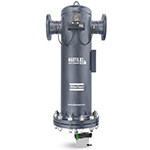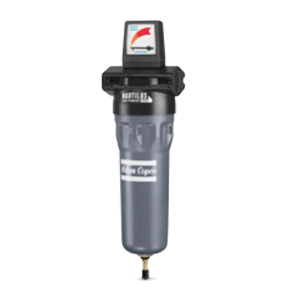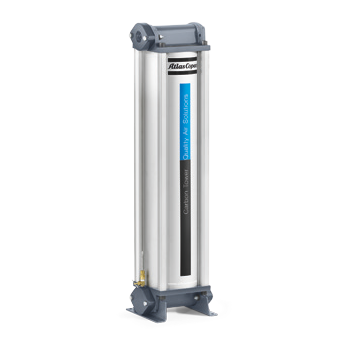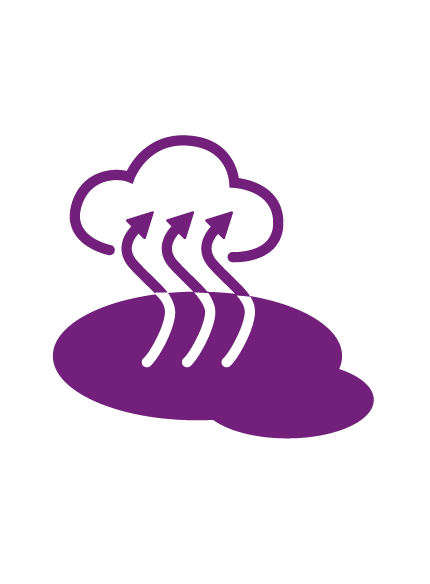Jump to topic
Filters by contaminants
Find the right filter below
By removing contaminants from the air stream, the right filter can significantly lower operating costs, ensure that even the most stringent air purity standards are met and extend the service life of air systems and pneumatic equipment.
And there are no better filters than those from Atlas Copco. We have assembled a dedicated team of experts to develop cutting-edge filtration solutions. Over the years, they have innovated filter types and designs, processes and filtration media to give you best-in-class precision, reliability and lifetime.
The first step is to find out which type of contaminant(s) you have to protect your system from and determine the air purity class required for your application.
To optimally treat the air and protect it from harmful substances, Atlas Copco is offering a wide range of filters – each designed to counteract a specific threat, use the table below to select the right air filter based on contaminants. ⤸
Atlas Copco’s dedicated filtration team is always looking for ways to give you a competitive edge. Our new generation of filters features several innovations that make your air system more efficient and its operation easier. Here are just three examples.
The ideal filtration technology
To ensure that your system is optimally protected, our filters use different filtration technologies – each designed to take on a specific threat to your airstream. They include:
Wrapped media for wet particles: Wrapped media are known for their durability in wet and oil-contaminated environments. Our patented Nautilus technology combines multiple wrapped layers to offer constant air quality at the lowest pressure drop, even in the harshest working conditions.
Pleated media for solid particles:Pleating is the optimal technology for capturing dry particulates in compressed air. Pleated media have a large surface area and therefore ensure a longer filter service lifetime and lower pressure drop.
Macro-structured activated carbon: Macro-structured activated carbon has a larger surface compared to the typical carbon filter media, giving it a superior adsorption capacity and a steady performance over a longer time.
Cyclone for water: The use of centrifugal forces secures a proper separation of liquid water droplets in the air flow.
To find out more about our filter media and filtration innovations, check out this video
inPASS™ bypass
In addition to outstanding filters, you also get the revolutionary built-in bypass that allows you to service your filter without disrupting the air flow.
To you that means big investment savings by eliminating the need to install an expensive external piping bypass, lower operating and energy costs as well as reduced maintenance times.
Service indicator
To ensure constant air quality, a service indicator allows for an easy check of the filter’s running hours differential pressure, and the maintenance status. It can even send a remote alert.
Talk to an expert
Choosing the right filter is important and you want to get it right to optimally protect your system and minimize your investment costs. So, if you are still unsure which contaminant you have to filter out or which ISO class you have to meet, just get in touch with Atlas Copco and we will help you find the right solution.
- Compressed air filters 5.3 MB, PDF

Flanged design

Threaded design

Tower design
Name |
DDp+ |
PDp+ |
DD+ |
PD+ |
UD+ |
QD+ |
QDT+ |
Grade |
Rough |
Fine |
Rough |
Fine |
Ultimate |
Basic |
Optimal |
Contaminant |
Dry dust |
Oil aerosol/wet dust |
Oil vapor |
||||
Special applications
Name |
H High-pressure |
SFA Silicone-free |
||||
Grade |
Rough & fine |
Rough & fine |
Basic |
Rough & fine |
Rough & fine |
Basic |
| Contaminant | Dry dust | Oil aerosol/wet dust | Oil vapor | Dry dust | Oil aerosol/wet dust | Oil vapor |

Dry dust

Micro organism

Oil aerosol

Wet dust

Oil vapor

Water drops
Another way of finding the right filter is to look at your application to determine the air purity it requires according to the international ISO 8573-1:2010 standard. The table below shows the various ISO 8573-1:2010 air purity classes and the Atlas Copco filters and dryer-combinations that meet these classes. To learn more about ISO 8573-1:2010, check out our blog post.
ISO 8573-1:2010 class
|
Solid particles |
Water
|
Oil
(aerosol, liquid, vapor) |
||
Wet conditions |
Dry conditions |
||||
|
As specified by the customer* |
Oil-free compressor |
|||
1 |
DD+ & PD+ |
DDp+ & PDp+ |
Desiccant dryer |
DD+ & PD+ |
& QD+/QDT |
UD+ |
UD+ |
& QD+/QDT |
|||
2 |
DD+ |
DDp+ |
Desiccant dryer, rotary drum dryer |
DD+ & PD+ |
|
UD+ |
|||||
3 |
DD+ |
DDp+ |
Desiccant dryer, membrane dryer, rotary drum dryer |
DD+ |
|
4 |
DD+ |
DDp+ |
Membrane dryer, refrigerant dryer |
DD+ |
|
5 |
DD+ |
DDp+ |
Membrane dryer, refrigerant dryer |
- |
|
6 |
- |
- |
Membrane dryer, refrigerant dryer |
- |
|
Examples of typical installations
A |
Compressor - UD+ |
Air purity class ISO 8573-1:2010 [1:-:2] |
B |
Compressor - UD+ - Refrigerant dryer |
Air purity class ISO 8573-1:2010 [1:4:2]* |
C |
Compressor - UD+ - Refrigerant dryer - QDT - DDp+ |
Air purity class ISO 8573-1:2010 [2:4:1] |
D |
Compressor - UD+ - Desiccant dryer - DDp+ |
Air purity class ISO 8573-1:2010 [2:2:2] |
E |
Compressor - UD+ - Desiccant dryer - QDT - DDp+ - PDp+ |
Air purity class ISO 8573-1:2010 [1:2:1] |

